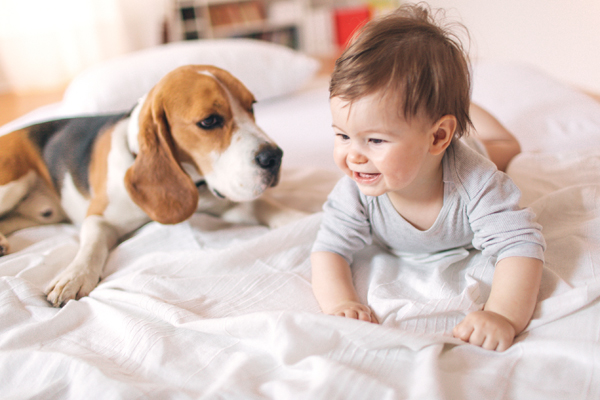Prep your pooch for baby

Personality type Think about how your dog acts when something […]
Personality type
Think about how your dog acts when something unexpected happens or a newcomer enters your home. Is he easy- going? Hyper? Anxious? “Every dog is different,” attests Hodgson, but you know your canine counterpart best, which is why you might be able to predict how your pet will respond.
Play pretend
“The best thing to do to prepare a dog for the reality of life with a baby is to bring a baby home now,” Hodgson counsels. “Not the baby, of course, but a doll.” Sure it’ll be made of rubber, but holding it, rocking it, and treating it like it’s the real thing will help acclimate your pup. Expert tip: If you have a friend with an infant, ask to borrow a blanket, and while you’re at it record a tantrum or two. “Get your dog socialized to the sounds and smells of a real baby,” suggests Hodgson.
Command center
Now is the time to bone up on your training rituals (think “sit,” “stay,” “lie down”). “My book makes learning with your dog a snap,” promises Hodgson. “Daily 10-minute rituals can have you on the road to good behavior in less than a week.” Use directions like “stay” while you go through the motions of changing a diaper or feeding a bottle with baby’s stand-in.
Follow the nose
Before the first meet-and-greet, bring a hospital blanket or mom’s shirt to whomever is watching your pup, so Fido can sniff around and become familiar with baby’s scent. “Remember dogs don’t use their eyes to see. Sight is a dog’s weakest sense. Dogs see with their noses.” When you bring your newbie home, ask a friend to be there. Even better: Have your BFF play or take a stroll with your pooch before you arrive, so your four-legged family member isn’t too energized when you walk through the door.
Caution tape
Some dogs—especially those who have zero experience with young children—might need special attention. “When you bring your baby home, listen to your dog with your eyes,” instructs Hodgson. “Dogs talk … with their body. Watch your dog’s eyes, ears, tail and posture to know how [he’s] feeling.” Need a cheat sheet? Find one at whendogstalk.com.
Images: iStock.com







